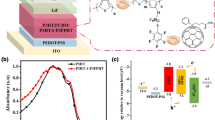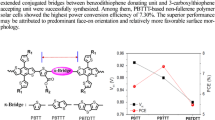Abstract
Polymer solar cells (PSCs) made by poly(3-hexylthiophene) (P3HT) with multi-adducts fullerenes, [6,6]-phenyl-C61-butyric acid methyl ester (PC61BM), PC61BM-bisadduct (bisPC61BM) and PC61BM-trisadduct (trisPC61BM), were reported. Electrochemistry studies indicated that PC61BM, bisPC61BM and trisPC61BM had step-up distributional lowest unoccupied molecular orbital (LUMO) energy. PSCs made by P3HT with above PC61BMs show a trend of enlarged open-circuit voltages, which is in good agreement with the energy difference between the LUMO of PC61BMs and the HOMO of P3HT. On the contrary, reduced short-circuit currents (J sc) were observed. The investigation of photo responsibility, dynamics analysis based on photo-induced absorption of composite films, P3HT:PC61BMs and n-channel thin film field-effect transistors of PC61BMs suggested that the short polaron lifetimes and low carrier mobilities were response for reduced J sc. All these results demonstrated that it was important to develop an electron acceptor which has both high carrier mobility, and good compatibility with the electron donor conjugated polymer for approaching high performance PSCs.
Similar content being viewed by others
References
Brabec CJ, Organic photovoltaics: Technology and market. Sol Energy Mater Sol Cells, 2004, 83: 273–292
Ma WL, Yang CY, Gong X, Lee KH, Heeger AJ. Thermally stable efficient polymer solar cells with nanoscale control of the interpenetrating network morphology. Adv Funct Mater, 2005, 15: 1617–1622
Li G, Shrotriya V, Huang JS, Yao Y, Moriarty T, mery K, Yang Y. High-efficiency solution processable polymer photovoltaic cells by self-organization of polymer blends. Nat Mater, 2005, 4: 864–868
Lenes M, Wetzlaer AH, Kooist FB, Veenstra SJ, Hummelen JC, and Blom PWM. Fullerene bisadducts for enhanced open-circuit voltages and efficiencies in polymer solar cells. Adv Mater, 2008, 20: 2116–2119
Lenes M, Shelton SW, Sieval AB, Kronholm DF, Hummelen JC, Blom PWM. Electron trapping in higher adduct fullerene-based solar cells. Adv Func Mater, 2009, 19: 3002–3007
Choi JH, Son KI, Kim T, Kim K, Ohkubo K, Fukuzumi S. Thienyl-substituted methanofullerene derivatives for organic photovoltaic cells. J Mater Chem, 2010, 20: 475–482
Keshavarz-K M, Knight B, Srdanov G, Wudl F. Cyanodihydrofullerenes and dicyanodihydrofullerene: The first polar solid based on C60. J Am Chem Soc, 1995, 117: 11371–11372
Hummelen JC, Knight BW, Wudl F, Yao J, Wilkins CL. Preparation and characterization of fulleroid and methanofullerene derivatives. J Org Chem, 1995, 60: 532–538
Sheng CX, Tong MH, Singh S, Vardeny ZV. Experimental determination of the charge/neutral branching ratio η in the photoexcitation of π-conjugated polymers by broadband ultrafast spectroscopy. Phys Rev, 2007, B75: 085206/1–085206/7
Lee CH, Yu G, Moses D, Pakbaz K, Zhang C, Sariciftci NS, Heeger AJ, Wudl F. sitization of the photoconductivity of conducting polymers by fullerene C60: Photoinduced electron transfer. Phys Rev, 1993, B48: 15425–15433
Haddon RC. Chemistry of the fullerenes: The manifestation of strain in a class of continuous aromatic molecules. Science, 1993, 261: 545–550
Lamparth I, Hirsch A. Water-soluble malonic acid derivatives of C60 with a defined three-dimensional structure. J Chem Soc Chem Commun, 1994, 14: 1727–1728
Li YF, Cao Y, Gao J, Wang DL, Yu G, Heeger AJ. Electrochemical properties of luminescent polymers and polymer light-emitting electrochemical cells. Synth Met, 1999, 99: 243–248
Scharber MC, Wuhlbacher D, Koppe M, Waldauf PC, Heeger AJ, Brabec CJ. Design rules for donors in bulk-heterojunction solar cells-towards 10% energy-conversion efficiency. Adv Mater, 2006, 18: 789–794
Lenes M, Kooistra FB, Hummelen JC, Van Severen I, Lutsen L, Vanderzande D, Cleij TJ, Blom PWM. Charge dissociation in polymer: Fullerene bulk heterojunction solar cells with enhanced permittivity. J Appl Phys, 2008, 104: 114517/1–114517/4
Jarzab D, Cordella F, Lenes M. Koolstra FB, Blom PW, Hummelen JC, Loi MA. Charge transfer dynamics in polymer-fullerene blends for efficient solar cells. J Phys Chem B, 2009, 113: 16513–16517
Guldi DM, Prato M. Excited-state properties of C60 fullerene derivatives. Acc Chem Res, 2000, 33: 695–703
Author information
Authors and Affiliations
Corresponding author
Rights and permissions
About this article
Cite this article
Gong, X., Yu, T., Cao, Y. et al. Large open-circuit voltage polymer solar cells by poly(3-hexylthiophene) with multi-adducts fullerenes. Sci. China Chem. 55, 743–748 (2012). https://doi.org/10.1007/s11426-012-4505-1
Received:
Accepted:
Published:
Issue Date:
DOI: https://doi.org/10.1007/s11426-012-4505-1




